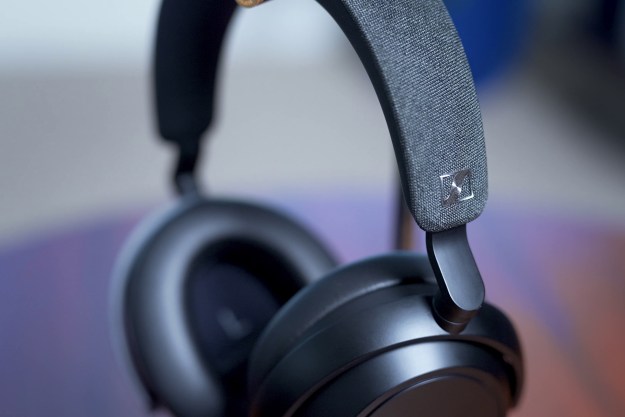- Radio Frequency transmission; easy to charge; comfortable; good sound stage
- Some interference issues (hard not to get with RF headphones)
Summary
The search for the perfect set of wireless headphones is often one fraught in disappointment and annoyance. First you have to decide between two technologies: Radio Frequency (RF) and Infrared (IR). At the very first step of the decision to go wireless, you are making a compromise since neither is perfect. RF is often plagued by interference and IR requires line of sight between the headphones and the base station. IR headphones tend to be interference free, since good placement of the base station can ensure a good connection. Either the connection is there and you have sound, or the line of sight is interrupted, and you have no sound. Quality is very binary: either the sound is present and at maximum quality, or it isn’t there at all. RF headphones operate on a gradient of connection quality. Depending on radio interference, your connection is almost never at maximum possible quality, but you have a more reliable connection.
Most tolerable wireless headphone sets are priced over $500, and most cheap ones are unusable. Thankfully, the Sennheiser RS130s are a nice compromise between price and quality that won’t break the bank or have you running for your tethered cans. Add to that great overall design and you have a very viable option for replacing your wired headphones.
Features and Design
The RS130s are very similar to the Sennheiser HD580s, one of the wired headphones on the market that Sennheiser sells. The appearances are slightly updated, with a more fluid design that doesn’t affect the acoustical qualities that have been a part of why Sennheiser
Along the right earpiece are volume controls and a frequency jump button that can be used if there is too much interference. To compensate for the inherent problems of radio interference with RF headphones, most companies employ some form of technology to overcome interference, and this along with driver quality, is 99% of what makes a quality wireless headphone. The Sennheiser RS130s use a frequency jumping technology and allow the user to manually jump frequencies. Along the left earpiece is the On/Off button.
The base station has only two buttons: one for activating the SRS Surround mode, and another for selecting one of three channels. The only audio input is through an attached RCA cord, which means are no purely digital signals. Also, the cord is hard wired into the base, which is inconvenient if you want to use a higher quality audio cable. Sennheiser includes adapters to connect RCA inputs from small and large stereo plugs. One thing that we thought was a great design choice was the recharging method. To recharge the headphones, just rest them on the stand. Metal contacts on the top of the
Sennheiser RS 130
Performance
Sennheiser claims range as high as 100 meters. We found that there were brief crackles in the signal whenever we passed by an obstacle. For instance, when we walked into a room, as soon as the wall was between the headphones and the base, there was a brief ¼ second of background fuzz. Afterwards, walking around behind the wall, the quality remained the same as sitting next to the base station. We were able to walk two floors below the base in our converted factory loft before the interference became intolerable. One more floor and we lost the signals completely. It was not 100 meters, but with cement brick and steel blocking the signal, we are comfortable in saying that most mid-sized, two story homes made with standard materials should find the signal strong throughout the house. It should be noted that this testing was done in a downtown setting with many sources of possible interference. Within 10 feet of the base station alone, we had a dozen sources of wireless interference.
Audio Quality
In terms of general audio quality, there was a very slight, but noticeable hiss that could be heard during silent periods in our testing. People fond of spoken word, classical, jazz and other music that emphasizes periods of silence might find these headphones borderline acceptable, unfortunately. Rock, techno, and other higher energy music performed very well. One interesting thing to note is that the noise suppression technology does a very good job of clarifying music based on the portion of the audio spectrum used. It’s difficult to describe, but based on our techno audition, we thought jazz would sound poor, but it actually sounded cleaner than the quieter periods of the electronic music. We decided to put the RS130s through the regular paces or music, movies and games.
Media:
– Bjork – “Vespertine” (DVD-Audio and MP3)
– Mahler – Symphony 10 – Berliner Philharmoniker (DVD-Audio)
– The Cure – “Disintegration” (Audio CD and MP3)
– Gary Numan – “Exile” (CD and MP3)
– Delerium – “Karma” (CD and MP3)
– Assemblage 23 – “Storm” (Audio CD and MP3)
– VNV Nation – “Futureperfect” (Audio CD and MP3)
– Louis Armstrong – “All Time Greatest Hits” (Audio CD and MP3)
Movies:
– Lord of the Rings: The Fellowship of the Ring (DVD)
– Spiderman 2 (DVD and UMD)
Games:
– Unreal Tournament 2004
– Doom 3
– City of Heroes
– Half-Life 2
– Counterstrike: Source
Sources:
– SoundBlaster Audigy 2 ZS Platinum Pro
– iRiver SlimX 350
– Apple iPod photo
– Sony Playstation Portable
– Yamaha RX-V2200 Receiver
All MP3s encoded with VBR 160kbps-320 kbps/44kHz. Base station was approximately four feet from the headphones, as quality did not degrade significantly within a distance appropriate for regular use (20 feet).
In all, sound quality and imaging were very nearly identical to the high quality Sennheiser HD580s in almost every respect. The sound stage was perfectly sized: not too wide, and not too far. The listener feels like they are observing the music at a comfortable distance, rather than inside the source or watching it through binoculars. All frequency ranges, lows, mids, and highs, were excellent, with slightly weak bass, but accurate and smooth.
Techno and industrial sounded great. The RS130s had clear highs and mids, with a very slight lack of bass. Louis Armstrong sounded flat out great, which was surprising. Like the HD580s, the bass is more expansive and atmospheric than boomy or guttural. Delerium and Gary Numan sounded clear enough to make out nuances in lyrics, and had a very present ethereal atmosphere. The Cure sounded excellent with clear guitar chords. Bjork’s voice was well represented, but her music underrepresented and too quiet. This is most likely due to the lack of the thumping bass. The SRS Surround mode was not up to snuff during music playback and would regularly confuse instrument locations.
Movies sounded clear and crisp. Nothing stood out in our mind worth noting as far as audio flaws. We found the SRS mode to be relatively inaccurate in it’s projection of sounds to the back of the listener, and generally do not recommend using the surround mode for movies.
Games sounded generally decent, but not earth shattering. The expansive bass made for god atmosphere in games like Doom 3, but the lack of deep bass left us disappointed. Interestingly, the surround mode did a good job of surrounded the gamer in the atmosphere without hurting the localization of the sound, making this the only real instance where we found the surround mode to be reasonable.
Conclusion
The Sennheiser RS-130s are a simple, practical, and truly functional pair of headphones. While they do not outperform comparably priced Sennheiser wired models, the quality is clearly better than many wired offerings from other companies. While RF has yet to outperform IR in the transmission quality category, the ability to place the base station anywhere in the room, even behind obstructions, is very convenient. We found the surround mode to be decent, but forced and artificial sounding.
Although the Sennheiser RS130s still exhibit some of the inherent flaws of RF technology, namely an interference issue, the execution has helped to reduce crackling to a minimum. These headphones will not win over audiophiles, but the lack of digital inputs makes it clear this is not the intended audience. For everyday general use, the RS130s provide excellent audio quality, top shelf comfort, and the easiest recharging of any wireless headphone we’ve seen so far. This is the first reasonably priced
Pros:
– Uses Radio Frequency transmission,
– Easy to charge
– Comfortable to wear
– Good sound stage
Cons:
– Some interference issues
Editors' Recommendations
- Best headphone deals: AirPods, Sony, Sennheiser and more
- Sennheiser Accentum Plus aims at the middle ground between budget and baller
- The best Dolby Atmos soundbars for 2023
- Sennheiser’s Ambeo Soundbar Mini is a pricey, bedroom-sized Dolby Atmos speaker
- Updating our Sony WF-1000XM5 review






